A toast to alumni innovators in the beverage industry.
There Is Truth in Wine
Kate Norris ’04 isn’t good at keeping secrets. The wine industry, she says, is shrouded in them. And, with a select group at the helm of most companies, there’s little diversity in the players. So, with Division Winemaking Company, she’s working to level the playing field (vineyard).
Young, women entrepreneurs are a minority in the world of wine. Just 14% of lead winemakers in California are women — the state that makes 85% of all U.S. vino — according to a 2020 study from Santa Clara University. “I want to pull back the curtains, and to have people fall in love with the process and really know where their wine came from and exactly how it was crafted — and for wine to be part of their story and everyday lives too.”
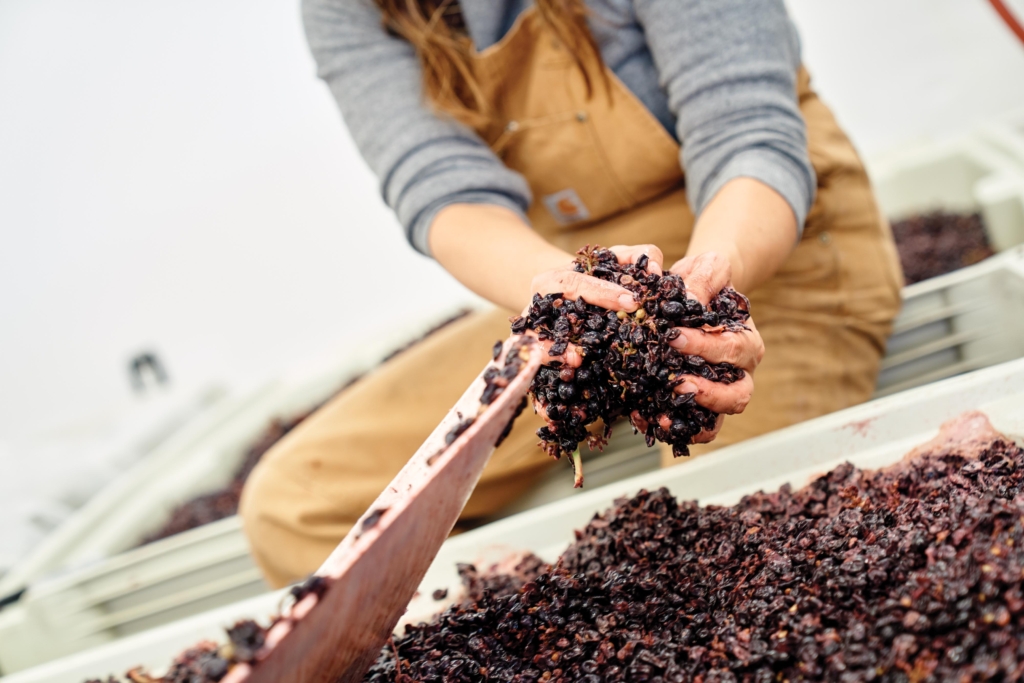
At Division Winemaking Company, there are no secrets. The Portland, Ore., company makes natural wine with the mantra of full transparency. For Norris, that means creating the beverage with minimal intervention, regenerative farming, and no herbicides or pesticides. The company follows the circadian rhythm of the earth: a process that relies on the vine and ecosystem’s internal clock to help guide farming and winemaking decisions, leading to higher quality, more interesting, and more sustainable wines.
That’s how Norris was brought up, with natural wine always on the table in her tiny French hometown of 300 people. The appreciation for the drink also came from her Malagasy mother and British father. “I like to say I’m a fifth-generation wine drinker,” she jokes. Norris graduated from Colgate with geography and political science degrees before entering the event-planning industry. Following the economic crash of 2008, she left that field and moved to the Beaujolais region of France to earn her degree in viticulture and oenology.
“The earth is different every year. I’m different every year. Wine is different every year.”
Kate Norris ’04, Division Winemaking Company
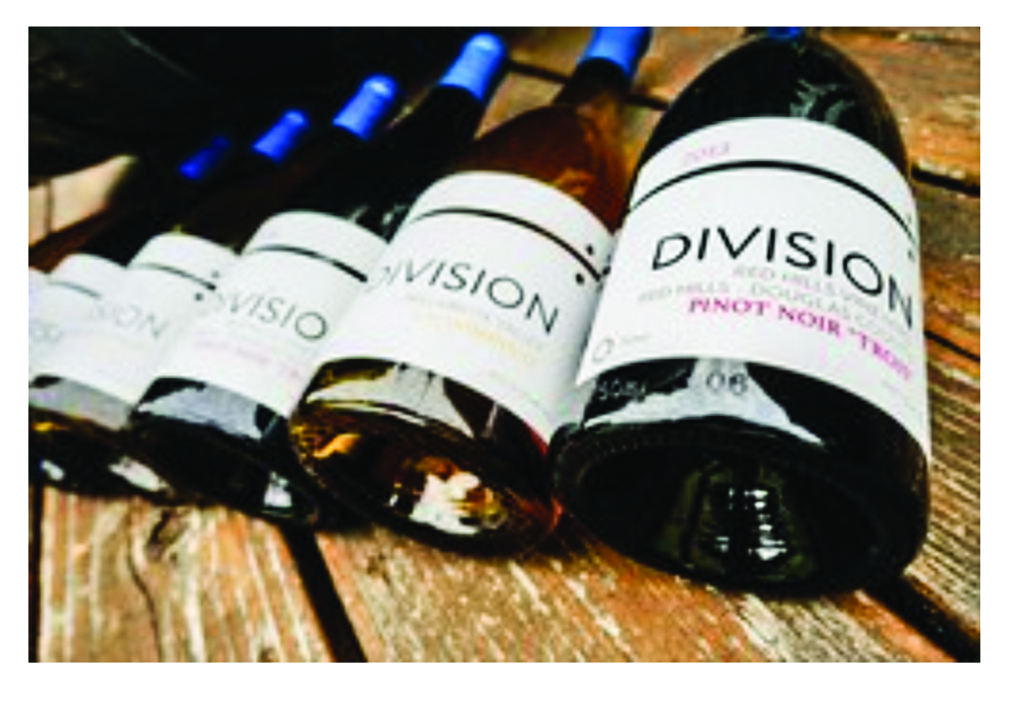
She honed her craft at wineries in Beaujolais, Burgundy, and the Loire Volcanique before moving back to the United States to open Division in 2010. She and her business partner, Tom Monroe, chose Oregon for its cool climate and culture. “It beats to its own drum,” Norris says. “It’s an incredible place to live and has a really welcoming and interested group of residents when you’re a maker wanting to create or craft something.” There, they lease and farm area vineyards, handling every part of the wine-making process.
Natural wine is “as old as time; it’s just finally been named,” Norris notes. “It’s how wines were originally made thousands and thousands of years ago. They didn’t have harsh chemicals or unnatural additives.” But, in recent years, it’s become a more trendy option at high-class dining establishments, delivering what some consider more of the purity of the grapes and terroir in each bottle than conventional vinos. At Division, that philosophy is spread among many grape varieties, from the expected Oregon Pinot Noir to the more daring “l’Orange,” a skin contact wine. This type of wine is made from whites grapes fermented on their skins (in the style of a red wine), giving a distinctive texture and an orange hue. Division’s orange wine blends eight white grape varieties and has notes of fresh tangerine peel and a touch of peat (plus eucalyptus, connecting to the art on its label). There are no recipes for wine, Norris stresses: “The earth is different every year. I’m different every year. Wine is different every year. Wine is different every day as it’s aging and also after you open it; a bottle is alive. And that’s just how it’s supposed to be.”
Next on the horizon: A building of their own. Division invested in a 10,000-square-foot building in southeast Portland that will serve as the company’s new urban winery. The space will allow Norris to take the business to the next level, with a goal of producing approximately 15,000 cases of wine per year — that’s a large rise from the current 8,000. “It will hopefully be our forever home … as long as we don’t outgrow it,” she says.
The Birth of Coffee in Williamsburg
Jason Scherr ’87 was a lawyer in Manhattan when he founded one of the first coffee shops in Williamsburg (Brooklyn). He wasn’t a total stranger to the food and drink business, previously founding an artisanal cream cheese company. But when friend Chris James ’87 moved to the Brooklyn neighborhood and showed Scherr what Williamsburg was all about, entering the coffee space made sense. “I fell in love with the neighborhood; at the time it was a very creative community on a lot smaller scale than it is now,” Scherr remembers. See how he started Think Coffee, which now has 11 locations and its own line of coffee beans.
Behind the Coffee
When Scherr moved to Williamsburg in 1996, he paid $200 per month to live in an enormous loft. Now, the average rent for a one-bedroom apartment is $3,000. At the time, “[Williamsburg] was the place that no one wanted to live in,” Scherr says. He saw that as an opportunity to build community. “I met an early internet guy, who wanted to promote local businesses through the web. We got to talking, and we decided there was no place to hang out in Williamsburg. We decided to open a coffee shop.”
Together, they renovated Verb Café (which Scherr would use as the model for Think Coffee) by hand. He was still working as a lawyer in Manhattan, but when the coffee shop’s candidate for manager fell through, he decided to fill the role himself. “I really enjoyed the community aspects of it. When September 11th happened, [the coffee shop] was the place to hang out and grieve together and come together as a community. It became clear to me that coffee and coffee shops were great places to build human connection.”
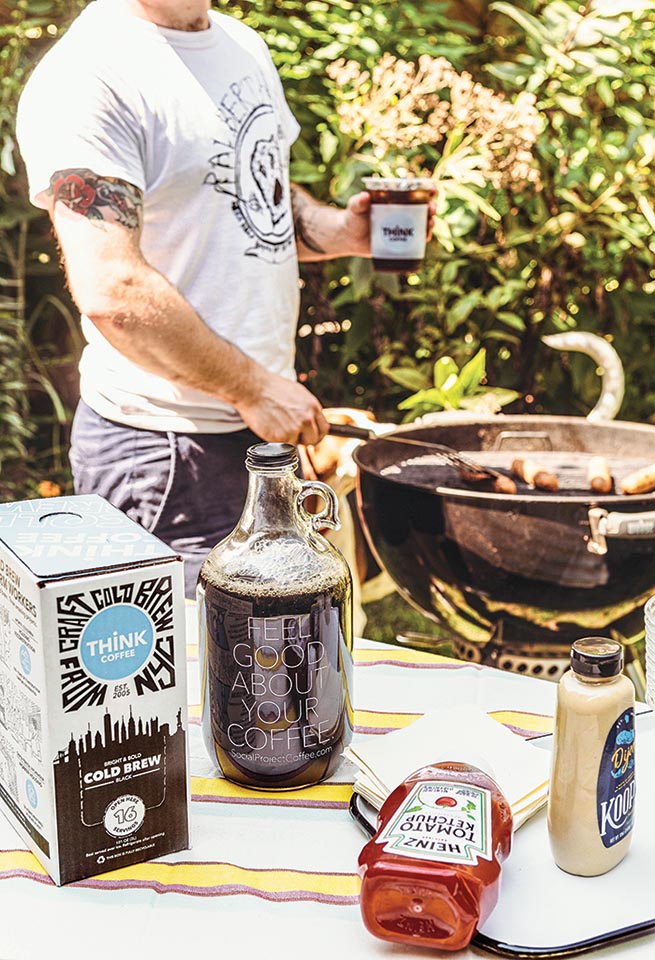
But one small coffee shop in a non-touristy area of New York City wasn’t enough to pay the bills. So Scherr scaled up. After a successful expansion to NYU’s campus, he continued opening new locations. “I took the lesson of the community and coming together and trying to build goodwill with our customers. I made that an integral part of our Think Coffee plan.”
Spilling the Beans on the Beans
Think Coffee offers blends from Nicaragua, Colombia, and Ethiopia, with a range of tasting notes. “We realized the best way to make great coffee was to travel to where it was grown and meet the farmers who grow it,” Scherr says. “We flew to Nicaragua and Honduras, we met people, and tried to find farmers who wanted to do the right thing by their workers.” That community aspect of the business was in the back of his mind as he explored ethical ways to produce beans for Think Coffee’s customers: He wanted to find coffee bean farmers who paid their employees fair wages and considered their well-being.
In addition to working with farmers who care for their employees, the company takes it a step further by giving back to the communities where the coffee is made. Scherr and co. have taken on projects such as installing wells in a community where workers didn’t have access to clean drinking water. Now they’re working on a menstrual hygiene project in Ethiopia. “Our challenge is that it’s not easily scalable, but we hope that, in partnership with our farmers and producers, we’re able to do some good for the worker communities that pick the coffee [beans for] your cup. We’re trying to make that connection.”
Pivoting in Current Times
Like many physical café locations, Think Coffee has struggled during the pandemic. To keep the business afloat, the company launched a boxed cold brew, similar in looks to boxed wine. “We’re promoting the idea that people should have our cold brew on tap, either at their office to welcome them back, or to give them a café-quality coffee break at home while they’re working. We think that people miss that sort of coffee break.”
What’s Scherr’s morning preference? Think Coffee’s Devoe blend, which is one of the more popular blends. “People are drinking what I like,” he jokes.
And That’s the Tea
Before the autumn leaves even fall to the ground, pumpkin spice coffees rule grocery store displays and drive-thru windows. But what if you’re not into coffee?
What if you’re a tea drinker?
“I’m currently drinking a pumpkin spice black tea,” says Bianca Koerfer ’12 McVaugh,
research and development and commercialization manager at Harris Tea Company. “I always like to drink the new items, even if it’s not exactly the right season for it.”
McVaugh hasn’t bought a single bag of tea (unless it’s to test a competitor’s product) since she started working as an associate scientist for the company, which is under the umbrella of Harris Freeman & Co., in 2016. She joined the business after earning her master’s in food science at the University of Wisconsin. The degree offered hands-on career options: “You can’t see molecules,” McVaugh says. “You learn all the theory, but I like more of the applied science.” She also liked the job security it promised: “The food industry is a field that’s never going to go away. People need to eat.”
McVaugh’s days are filled with producing the tea you see on your weekly shopping trip. But, when you see a box of tea, you should envision a few people. There are growers all over the world, teams sourcing the leaves, groups handling the logistics of getting the tea to the factories, and the quality-control branch making sure that blends taste the way they should and bags aren’t accidentally ripping. McVaugh is on the research and development arm, and her main role is scaling up products from bench-top to full manufacturing. Two scientists report to her, and she assigns new projects (like new flavors of black tea).
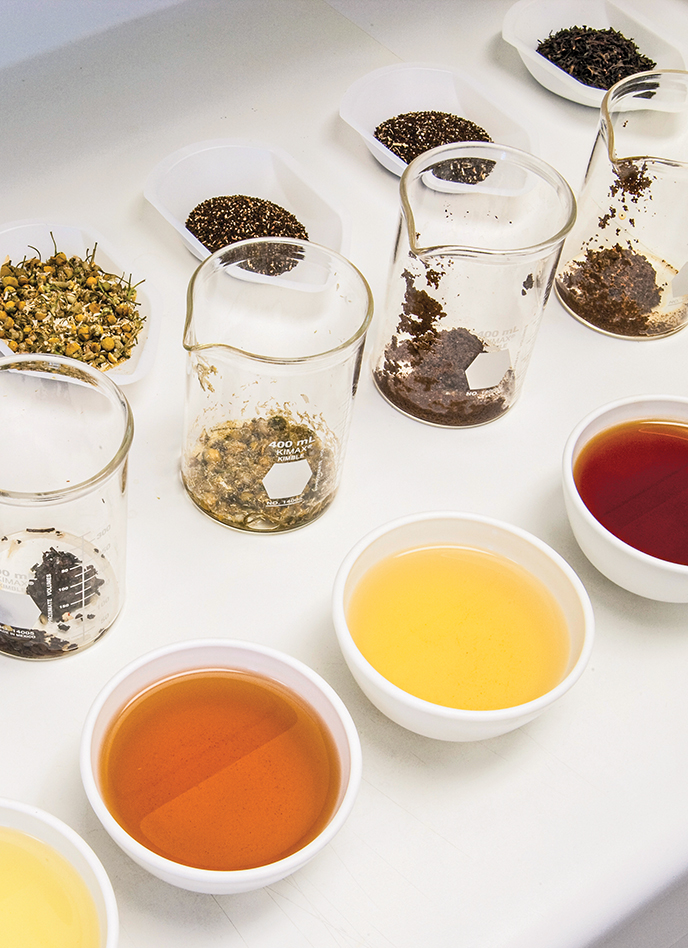
McVaugh is New Jersey–based, and many of the teas in her portfolio are herbal because, when it comes to tea, location matters. “[In] the Northeast, iced tea isn’t a thing,” she says. While some northerners might order tea in a restaurant, southerners drink sweet tea regularly. In the Northeast, on the other hand, the company can’t keep up with the demand for herbal specialty flavored teas.
Aside from herbal options, much of McVaugh’s job involves working backward. Harris Tea Company manufactures both in-house tea brands and fulfillments for outside customers. For example, big grocery store brands will come to the company to match another kind of tea so the store can release it under its own brand. “A lot of work in the food industry is matching other people’s products,” McVaugh says. “We have hundreds of blends in our portfolio, but we pack a lot of the same ones for different customers.”
A lifetime tea drinker, McVaugh feels at home among the tea bags she touches each day. In the morning, she reaches for a cup of Earl Gray. “I like drinking black tea in the morning just because it is a caffeine source,” she says. But in the afternoon, all bets are off. “I’m always excited when I see a blend that we don’t pack that often.” Next up, gingerbread.
They Have a Can-Do Attitude
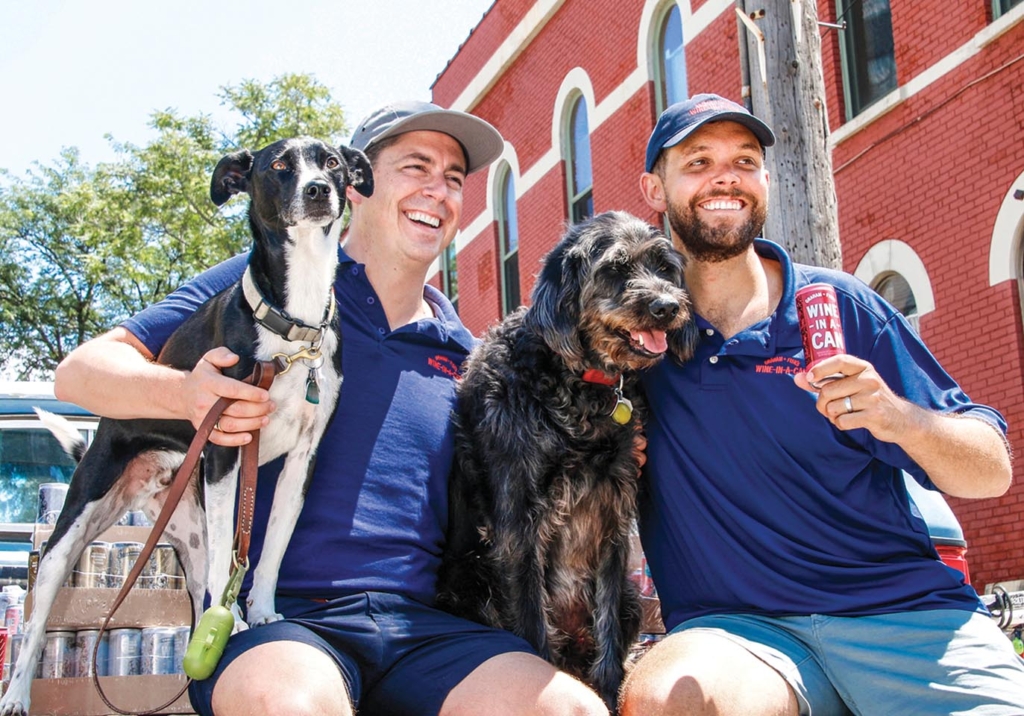
Imagine 1991. You’re at Camp Roosevelt on the shores of Lake Erie, spending the neverending days swimming and hiking to your heart’s content. Distantly, you hear Bryan Adams through a camp radio.
Across the way, you see fellow campers Graham and Fisk meet and begin a lifelong friendship — a friendship that would culminate in an unusual business venture: canned wine. In 2015, Fisk Biggar ’05 and Graham Veysey launched Firehouse Can Company, “the first exclusively canned wine company in the United States.” The story goes like this: Veysey was working day and night to renovate a vacant firehouse in Cleveland to help revitalize the city. Covered in construction dust, he wandered over to the neighborhood bar, craving wine. “[I wanted] to give my beer belly the night off and was curious why there wasn’t wine in a can,” Veysey remembers. He got Biggar in on the idea, and the two have worked since then to fill a hole in the wine market. Now, the company produces Graham + Fisk’s Wine-in-a-Can and MANCAN Wine.
But it’s not just any old business venture. Biggar and Veysey put themselves on the line with every can. Their names are on full display, taking ownership with each sip. That firehouse Veysey renovated? It’s on there, too. And then there are the dogs, Gracey (who has the black-and-white coat of the typical firehouse dog) and Crosby (the office grouch). Every decision was made with the goal of creating a connection with the consumer. “We see our customers more like drinking buddies than anything else,” Veysey says.
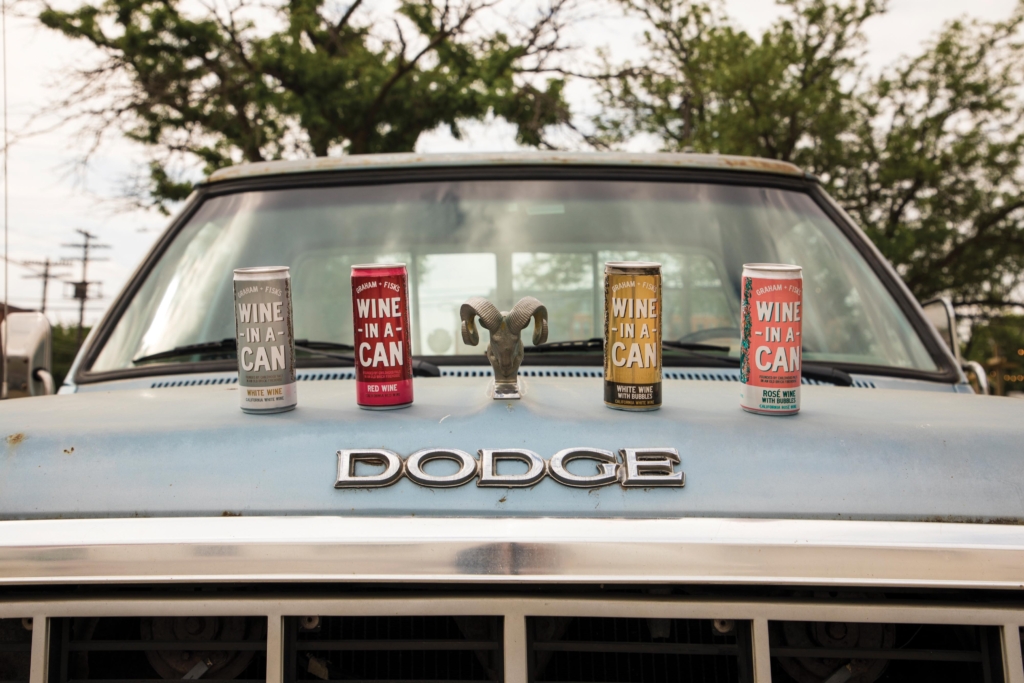
Though the business is based in the Cleveland firehouse, each can carries 100% California wine with “universal drinkability,” the pair says. “We want to make awesome wine,” Biggar says. “If we’re going to put wine in a can, there are going to be skeptics, so we’ve got to make sure we deliver a really high-quality product.” Each varietal is approachable, with simple options like red wine, white wine (with and without bubbles), and rosé with bubbles. The company mixes things up for holidays, with special boxes like the 2021 Advent Calendar, featuring 24 cans.
Six years into the venture, Biggar and Veysey have earned seven Best Buy awards from Wine Enthusiast and have expanded to stores like Whole Foods and Walmart. But they still see this as the beginning: “Jeff Bezos said, ‘Overnight success takes 10 years,’” Biggar relates. “We’ve got a long way to go.”
Despite Her Last Name, She’s in Liquor
Before you finish reading this, grab a glass of whiskey. We’ll wait.
Now that you’re settled, take a look at the bottle. There’s a good chance Stacey Beerman ’10 is behind the liquor you’re sipping. As global senior brand manager of American whiskey at Campari, she’s responsible for looking at the longer-term brand-building strategy of the drink. “The global marketing team puts together the vision for the brand and develops a lot of the assets for the campaigns that are going to be launched globally. It’s a way of consolidating resources and making sure that our brand stands for the same thing in every country.” Have a drink with Beerman.
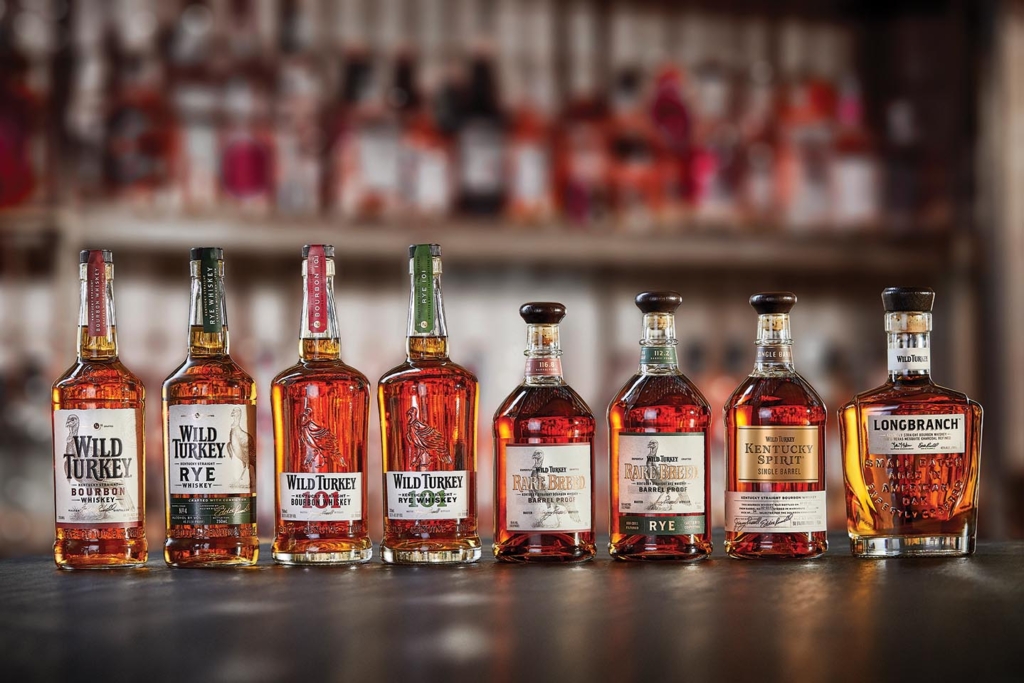
When she interviewed for the job, she didn’t drink whiskey. Her soon-to-be boss saw that as an upside: “He said, ‘That was actually one of the reasons why [I wanted to] hire you, because we can recruit non–whiskey drinkers.’”
At Campari, she had to flip the script. Her previous job as associate brand manager at Colgate-Palmolive relied heavily on promoting the benefits of the company’s products (like toothpaste, where you can talk about how many times whiter your teeth can be). But it’s illegal to claim the benefits of liquor in marketing. “A lot of consumption moments are around unwinding after a long day or turning up for a social interaction. We know consumers seek out different types of alcohol for these reasons, but legally we can’t say that alcohol will calm nerves or that a certain alcohol will get you drunk faster or make you feel better in the morning.”
She looks ahead to 2045. To predict future buying habits of consumers, her team utilizes trend forecasting. “We do long-term forecasting to determine, ‘What do we think the demand is going to be in 2025 and beyond, 2035, 2045?’” And because whiskey needs time to age, this forecasting helps determine what needs to be made today for release in years to come.
Now, she’s at the wheel. “I came onto the team and I was like, ‘My to-do list looks massive.’ When you work in brand management, they say you’re the center of the wheel, so you touch everything.” Day to day, Beerman splits her time among the supply chain, communicates with brand managers in different countries, and works with the innovation, packaging, and media teams.
The best part of the job? “Having the opportunity to taste different liquid ages, blends, and cask finishes for innovation.” You read that correctly — she’s now a whiskey drinker.
It’s Important to Know That You Will Not Get High From This Drink
The dinner party was winding down, and as her friends moved into the nightcap portion of the evening, Talia Bennick ’08 popped a CBD gummy into her mouth. It was the first time she’d tried cannabidiol in that format, and while it provided relaxation, the fun of eating the gummy was short-lived. “The whole experience was over in two seconds in terms of ingesting it,” Bennick remembers. It would be great, she thought, if there were something equally relaxing that she could sip on during the after-dinner conversation.
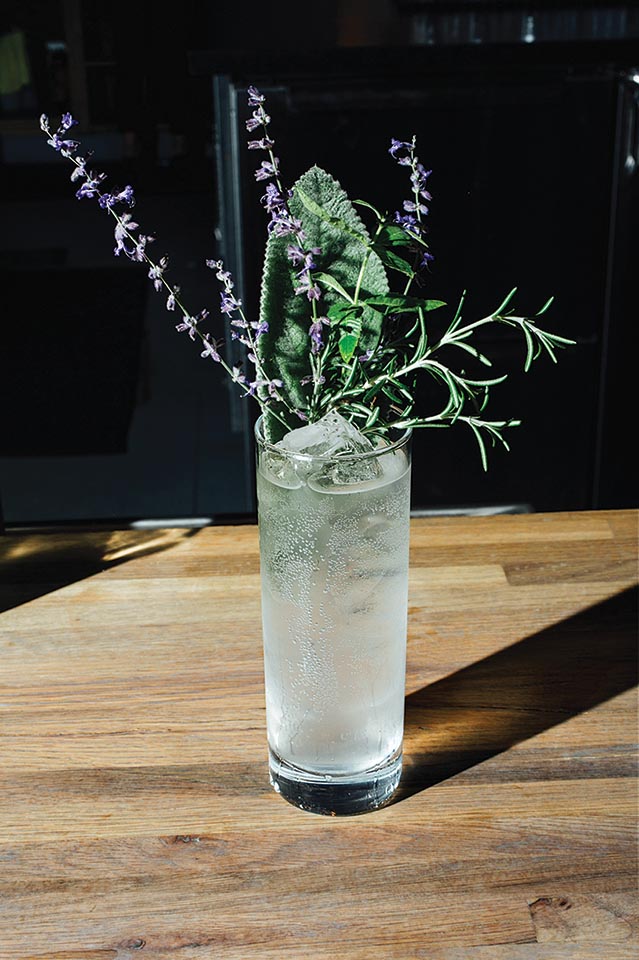
So she turned her kitchen into a lab and began work on what would become Crisp & Crude, a line of nonalcoholic CBD cocktails. It was a long time coming.
After earning her MBA at Yale, while working in hospitality technology, Bennick noticed trends of guests requesting nonalcoholic beverages. As someone who struggled with intense migraines triggered by alcohol, she knew that developing an alcohol-free drink would be both profitable and enjoyable.
“I started figuring out how to mix hemp extract into drinks that I was either enjoying myself or serving while hosting, and then from there, developing the recipes even more to what they are today.” Once she developed flavor profiles that tasted good, Bennick worked with a beverage scientist to balance them and create shelf-stable versions of the drinks. They also helped her build on the drinks’ initial notes by adding earthier elements like Siberian fir needle.
The canned cocktails — crafted both with and without CBD — have flavor profiles akin to classic drinks: Mellow Mule (Moscow Mule), OG Tonic (Gin and Tonic), and Paloma Daydream (Paloma). While most consumers enjoy them straight from the can, they can be used as mixers for alcoholic cocktails as well. “When I learned about CBD and botanical terpenes and their ability to help relax, I became really interested and started playing around with those in nonalcoholic cocktails,” Bennick says.
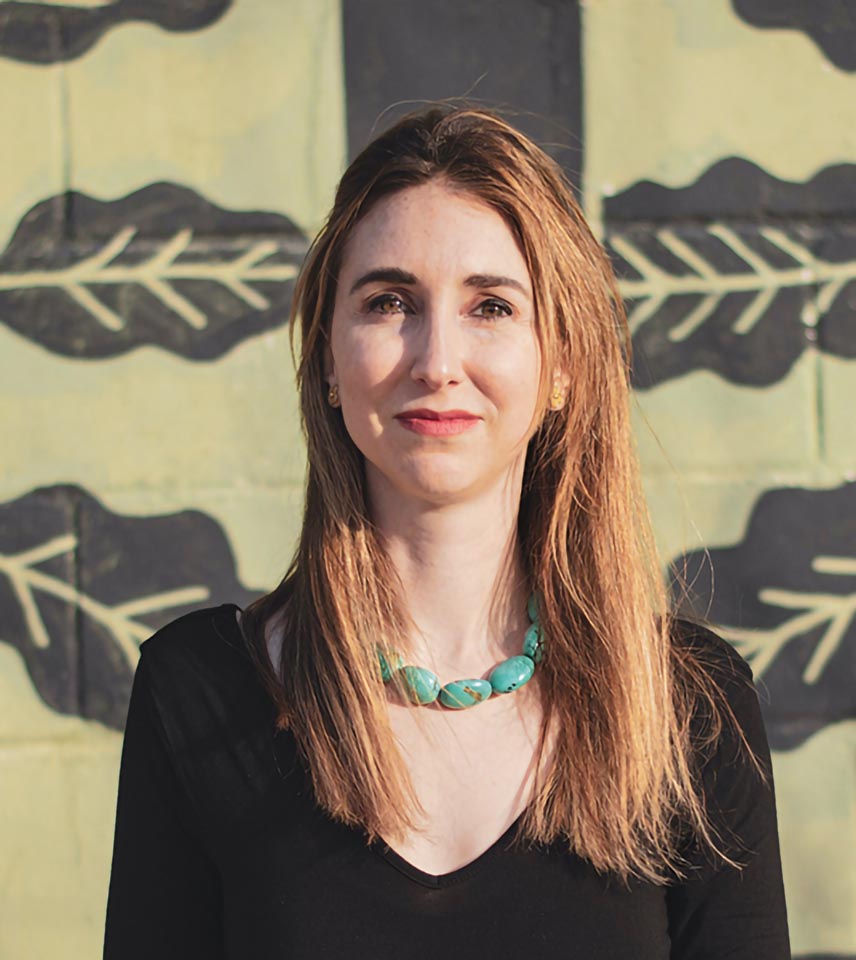
But, what you won’t get from these drinks: the psychoactive effects of marijuana. According to a 2020 article from Harvard Medical School, “While CBD is a component of marijuana (one of hundreds), by itself it does not cause a ‘high.’” Bennick is transparent about the ingredients in each can, with an FAQ on the Crisp & Crude website about the lesser-known ones, like Pineapple Express, “a strain defined by a terpene profile of tropical fruits and piney conifers.”
“Much like how we use lavender to be calming, there are some of those same botanical compounds that you’ll find in our drinks for their relaxing effects,” Bennick says. “It’s with intention not just for flavor, but also because we know that these herbs or roots or fruits can inspire that mind-body connection to let us let go and chill.”
“When I learned about CBD and botanical terpenes and their ability to help relax, I became really interested and started playing around with those in nonalcoholic cocktails.”
Talia Bennick ’08, Crisp & Crude
